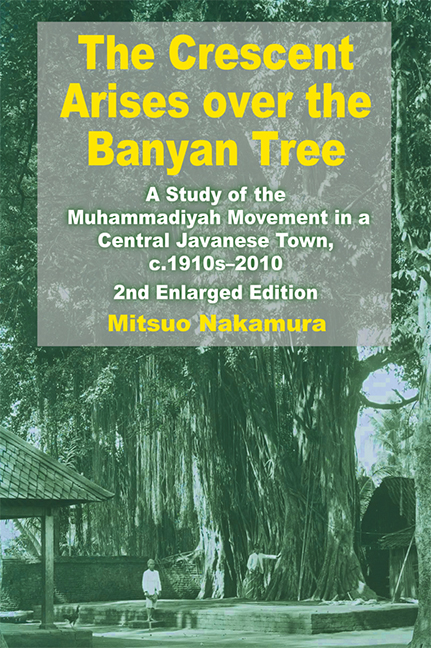 The Crescent Arises over the Banyan Tree
The Crescent Arises over the Banyan Tree Book contents
- Frontmatter
- Dedication
- Epigraph
- Contents
- List of Figures and Maps
- List of Tables
- List of Boxes
- Foreword to the Second Edition
- Preface to the Second Edition
- Foreword to the First Edition
- Preface to the First Edition
- Notes
- Map
- PART I DEVELOPMENT OF THE MUHAMMADIYAH IN KOTAGEDE, c.1910s–1972
- 1 Introduction: The Islamization of Java
- 2 Kotagede under the Banyan Tree: Traditional Society and Religion
- 3 The Beginning of the Muhammadiyah: Court Religious Officials and the Urban Middle Class
- 4 The Development of the Muhammadiyah: Religion and Social Action
- 5 The Sociology of Ummat Islam: Structure and Anti-Structure
- 6 The Ideology of the Muhammadiyah: Tradition and Transformation
- 7 Conclusion: Re-Islamization of Java
- Postscript to Part I
- PART II KOTAGEDE REVISITED, 1972–2010
- Bibliography
- Glossary
- Appendices
- Index
- About the Author
1 - Introduction: The Islamization of Java
from PART I - DEVELOPMENT OF THE MUHAMMADIYAH IN KOTAGEDE, c.1910s–1972
Published online by Cambridge University Press: 21 October 2015
- Frontmatter
- Dedication
- Epigraph
- Contents
- List of Figures and Maps
- List of Tables
- List of Boxes
- Foreword to the Second Edition
- Preface to the Second Edition
- Foreword to the First Edition
- Preface to the First Edition
- Notes
- Map
- PART I DEVELOPMENT OF THE MUHAMMADIYAH IN KOTAGEDE, c.1910s–1972
- 1 Introduction: The Islamization of Java
- 2 Kotagede under the Banyan Tree: Traditional Society and Religion
- 3 The Beginning of the Muhammadiyah: Court Religious Officials and the Urban Middle Class
- 4 The Development of the Muhammadiyah: Religion and Social Action
- 5 The Sociology of Ummat Islam: Structure and Anti-Structure
- 6 The Ideology of the Muhammadiyah: Tradition and Transformation
- 7 Conclusion: Re-Islamization of Java
- Postscript to Part I
- PART II KOTAGEDE REVISITED, 1972–2010
- Bibliography
- Glossary
- Appendices
- Index
- About the Author
Summary
But it should be clear … that the blanket use of the word “Islam” conceals the fact that one is not coming to terms with an abstraction, but with people; that the term is complex; it cannot meaningfully be discussed as a tide, but rather as a web of dynamisms and tensions. (Johns 1975, p. 36)
This is a study of ongoing Islamization in urban south Central Java focused on the case of a local branch of the Muhammadiyah movement in the town of Kotagede, the Special Region of Yogyakarta. (See Map 1.) This study attempts to present the argument that the Muhammadiyah movement in the town is a contemporary manifestation of the historically continuing process of Islamization, that its development has been related to changes in the social, economic, political aspects of the town, that it is transmitting and yet transforming local religious traditions so that they approach more closely to the orthodoxy of Islam, and that this process of Islamization in the town is likely to progress in the future.
THE MUHAMMADIYAH IN THE ISLAMIZATION OF JAVA
The Islamization of Java, especially its early history, has been a subject debated by generations of historians of Java. Ramified arguments and counter- The Crescent Arises over the Banyan Tree arguments have developed among them concerning such questions as when, where, how, and why the Javanese population started to accept Islam as their professed religion and who played what role in the historical process. In spite of considerable scholarly efforts so far devoted to answering these questions, comprehensive and definitive works have yet to appear. Although I have no intention of participating in these arguments, nor do I have expertise to do so, my field observation in the town of Kotagede and my inquiry into its local history have led me to question some of the premises underlying the previous studies on the historical Islamization of Java, as shall be discussed later in this Introduction.
- Type
- Chapter
- Information
- The Crescent Arises over the Banyan TreeA Study of the Muhammadiyah Movement in a Central Javanese Town, c.1910s-2010 (Second Enlarged Edition), pp. 3 - 17Publisher: ISEAS–Yusof Ishak InstitutePrint publication year: 2012
